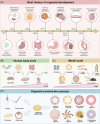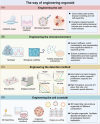Organoids: development and applications in disease models, drug discovery, precision medicine, and regenerative medicine
- PMID: 39309690
- PMCID: PMC11416091
- DOI: 10.1002/mco2.735
Organoids: development and applications in disease models, drug discovery, precision medicine, and regenerative medicine
Abstract
Organoids are miniature, highly accurate representations of organs that capture the structure and unique functions of specific organs. Although the field of organoids has experienced exponential growth, driven by advances in artificial intelligence, gene editing, and bioinstrumentation, a comprehensive and accurate overview of organoid applications remains necessary. This review offers a detailed exploration of the historical origins and characteristics of various organoid types, their applications-including disease modeling, drug toxicity and efficacy assessments, precision medicine, and regenerative medicine-as well as the current challenges and future directions of organoid research. Organoids have proven instrumental in elucidating genetic cell fate in hereditary diseases, infectious diseases, metabolic disorders, and malignancies, as well as in the study of processes such as embryonic development, molecular mechanisms, and host-microbe interactions. Furthermore, the integration of organoid technology with artificial intelligence and microfluidics has significantly advanced large-scale, rapid, and cost-effective drug toxicity and efficacy assessments, thereby propelling progress in precision medicine. Finally, with the advent of high-performance materials, three-dimensional printing technology, and gene editing, organoids are also gaining prominence in the field of regenerative medicine. Our insights and predictions aim to provide valuable guidance to current researchers and to support the continued advancement of this rapidly developing field.
Keywords: animal models; disease model; drug screening organoids; personalized medicine.
© 2024 The Author(s). MedComm published by Sichuan International Medical Exchange & Promotion Association (SCIMEA) and John Wiley & Sons Australia, Ltd.
Conflict of interest statement
The authors declare no conflict of interest.
Figures



Similar articles
-
Advancement of Organoid Technology in Regenerative Medicine.Regen Eng Transl Med. 2023;9(1):83-96. doi: 10.1007/s40883-022-00271-0. Epub 2022 Aug 8. Regen Eng Transl Med. 2023. PMID: 35968268 Free PMC article. Review.
-
An Exploration of Organoid Technology: Present Advancements, Applications, and Obstacles.Curr Pharm Biotechnol. 2024;25(8):1000-1020. doi: 10.2174/0113892010273024230925075231. Curr Pharm Biotechnol. 2024. PMID: 37807405 Review.
-
Organoid-Guided Precision Medicine: From Bench to Bedside.MedComm (2020). 2025 May 1;6(5):e70195. doi: 10.1002/mco2.70195. eCollection 2025 May. MedComm (2020). 2025. PMID: 40321594 Free PMC article. Review.
-
Progress and perspective of organoid technology in cancer-related translational medicine.Biomed Pharmacother. 2022 May;149:112869. doi: 10.1016/j.biopha.2022.112869. Epub 2022 Mar 28. Biomed Pharmacother. 2022. PMID: 35358798 Review.
-
Organoids: The current status and biomedical applications.MedComm (2020). 2023 May 17;4(3):e274. doi: 10.1002/mco2.274. eCollection 2023 Jun. MedComm (2020). 2023. PMID: 37215622 Free PMC article. Review.
Cited by
-
Antibacterial activity of the novel peptide Pac-525 with the RGD motif against intracellular Escherichia coli.Sci Rep. 2025 Jun 6;15(1):19995. doi: 10.1038/s41598-025-04901-9. Sci Rep. 2025. PMID: 40481070 Free PMC article.
-
Combination of tumor organoids with advanced technologies: A powerful platform for tumor evolution and treatment response (Review).Mol Med Rep. 2025 Jun;31(6):140. doi: 10.3892/mmr.2025.13505. Epub 2025 Apr 4. Mol Med Rep. 2025. PMID: 40183402 Free PMC article. Review.
-
Human cerebral organoids: Complex, versatile, and human-relevant models of neural development and brain diseases.Neural Regen Res. 2026 Mar 1;21(3):837-854. doi: 10.4103/NRR.NRR-D-24-01639. Epub 2025 May 6. Neural Regen Res. 2026. PMID: 40364645 Free PMC article.
-
Towards a Better Understanding of the Human Health Risk of Per- and Polyfluoroalkyl Substances Using Organoid Models.Bioengineering (Basel). 2025 Apr 7;12(4):393. doi: 10.3390/bioengineering12040393. Bioengineering (Basel). 2025. PMID: 40281753 Free PMC article.
-
The Risks Associated with Inhalation Exposure to Cosmetics and Potential for Assessment Using Lung Organoids.Bioengineering (Basel). 2025 Jun 13;12(6):652. doi: 10.3390/bioengineering12060652. Bioengineering (Basel). 2025. PMID: 40564468 Free PMC article. Review.
References
-
- Thomson JA, Itskovitz‐Eldor J, Shapiro SS, et al. Embryonic stem cell lines derived from human blastocysts. Science. 1998;282(5391):1145‐1147. - PubMed
-
- Takahashi K, Yamanaka S. Induction of pluripotent stem cells from mouse embryonic and adult fibroblast cultures by defined factors. Cell. 2006;126(4):663‐676. - PubMed
-
- Sato T, Vries RG, Snippert HJ, et al. Single Lgr5 stem cells build crypt‐villus structures in vitro without a mesenchymal niche. Nature. 2009;459(7244):262‐265. - PubMed
-
- Park DS, Kozaki T, Tiwari SK, et al. iPS‐cell‐derived microglia promote brain organoid maturation via cholesterol transfer. Nature. 2023;623(7986):397‐405. - PubMed
Publication types
LinkOut - more resources
Full Text Sources
